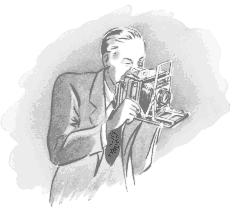| View previous topic :: View next topic |
| Author |
Message |
wood_raymond79
Joined: 06 Mar 2004
Posts: 10
|
 Posted: Mon Mar 15, 2004 3:31 am Post subject: Posted: Mon Mar 15, 2004 3:31 am Post subject: |
 |
|
I AM ABOUT TO BEGIN RESTORATION ON A 'CROWN VIEW' CAMERA THAT I RECENTLY PURCHASED. ANY POINTERS ON RESTORATION OR LINKS TO RESTORATION SITES WOULD BE GREAT. EVERYTHING NEED TO BE DONE. THE WOOD NEEDS CLEANING, THE BRASS NEEDS POLISHING, AND THE CANVASS BELLOWS NEEDS WORK ON ALL ITS CORNERS. THE ONLY PIECE THAT DOESN'T REQUIRE WORK IS THE LENS. THE BACK ON THE CAMERA WAS OBVIOUSLY HOMEMADE. IT CONSISTS OF A METAL Graflok BACK SCREWED INTO THE ORIGINAL WOOD PANEL BACK (I THINK), ANYWAYS IT LOOKS TERRIBLE AS A COLLECTABLE. DOES ANYONE KNOW WHERE I CAN FIND THE PROPER WOOD BACK ******* OR AT LEAST A SCHEMATIC DRAWING? I ALSO REQUIRE THE 4X4 WOOD/BRASS RECESSED LENSBOARD.
IN ANY CASE I WILL BE KEEPING NOTES THROUGHOUT THE PROCESS AND WILL POST A REPORT WHEN FINISHED. THANKS IN ADVANCE.
|
|
| Back to top |
|
 |
45PSS
Joined: 28 Sep 2001
Posts: 4081
Location: Mid Peninsula, Ca.
|
|
| Back to top |
|
 |
suburban grafic
Joined: 01 Feb 2004
Posts: 19
Location: Arizona
|
 Posted: Tue Mar 16, 2004 7:26 am Post subject: Posted: Tue Mar 16, 2004 7:26 am Post subject: |
 |
|
Having walked in your shoes more than a couple of times, I would suggest doing the following: Relax, put the camera in front of you. Get out your small amd medium screwdrivers. Without turning any screws, make sure that you have the appropriate sized driver for every screw on your camera.
Next, get a big sheet of paper and about twenty (or as many you think you will need) small plastic cups. Draw a rough sketch of each piece you take from the camera and place the drawing with the piece and related screws in a cup. Once you have done this, you should have a lot of appropriately labeled cups full of pieces of brass or whatever and their corresponding screws in front of you.
Ignore them for a while. You should now have a lot of milled pieces of hardwood in front of you. Now, you have to strip, not sand the old finish off. Forget about patina and all that crap. Brush on remover liberally and let it do its job.
Continue doing this until you have a lot of clean peices of wood in front of you. Let everything dry for about two days. Now, you can begin to lightly sand off the whiskers and other whatnot that the stripper was too lazy to remove. At this point, you should be working with bare, unstained wood.
Forget about refinishing with that spraycan crap. Go to Ace and get a pint of highest quality spar varnish. A good (=expensive) one inch sable brush is also in order.
Stain the wood of your camera if you wish with a high quality oil based stain of the tint of your choice. Apply the stain and let it dry for two days. If the shade is not to your choice, use your noggin and work the stain again:-)
Now you can use the spar varnish. Long, lightly applied stokes will give you a good finish. Let it dry! (one or two days?) When it is dry, a few very light strokes across the high points with the finest garnet paper you can find will prepare the surface for the next layer of varnish. Dry well between each coat and after four or five coats you will have some outstandingly finished pieces of wood.
I can't believe I wrote all this and I still haven't told you about how to work the metal parts and polish all those litte screws.
When you have your wood finished and it looks better that a "factory" finish, let me know in this thread and I will tell about my experiences refinishing the metal parts of wood cameras.
Get busy!!!!!!!!!!
_________________
If it weren't for me, where would I be? |
|
| Back to top |
|
 |
wood_raymond79
Joined: 06 Mar 2004
Posts: 10
|
 Posted: Fri Mar 26, 2004 3:29 am Post subject: Posted: Fri Mar 26, 2004 3:29 am Post subject: |
 |
|
Thanks for the advice. Unfortunately I didn't know it was posted until today and have already coated the focusing rails and associated brass with clear acrylic. Everything came apart easily and the screws seem to be holding tight when replaced. I used a bit of rubber cement in the screw holes just to make sure. The brass came clean with brasso and I used a stripper and scotch brite to clean the wood. This process seems to be working well.
What to do about the bellows is a mystery to me. The bellows is made of painted canvass, the corners of which are bare of paint and thus leaking light.
|
|
| Back to top |
|
 |
wood_raymond79
Joined: 06 Mar 2004
Posts: 10
|
 Posted: Fri Mar 26, 2004 3:31 am Post subject: Posted: Fri Mar 26, 2004 3:31 am Post subject: |
 |
|
I will also have to remove the canvass bellows from the frame to continue. It seems glued in place. Would a solvent be the way to go about removing this? Should I just sacrifice a section of bellows?
|
|
| Back to top |
|
 |
|


